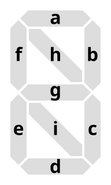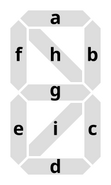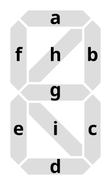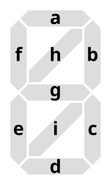A nine-segment display is a type of display based on nine segments that can be turned on or off according to the graphic pattern to be produced. It is an extension of the more common seven-segment display, having an additional two diagonal or vertical segments (one between the top and the middle, and the other between the bottom and the horizontal segments). It provides an efficient method of displaying alphanumeric characters.
The letters displayed by a nine-segment display are not consistently uppercase or lowercase in shape. A common compromise is to use a lower-case "n" instead of "N". Depending on the design of the display segments, the use of the extra two segments may be avoided whenever possible, as in the Nixxo X-Page "tall" lowercase "r" and "y". Perhaps to avoid this awkward inconsistency, the Scope Geo N8T does not allow the use of uppercase or lowercase versions of the letters "J" (even though it could easily be displayed on a 7-segment display). Some other letters like "K", "Q", "W" (even though this would appear as an upside-down M), and "X", "Y" (even though it could easily be displayed on a 7-segment display), and "Z".
Designs[]
- The gallery above shows various nine-segment display designs.
- The left one resembles the K-shaped design within the conventional seven-segment display.
- The second one from the right is used for Russian postcodes.
- The Elektronika 4-71b calculator from Russia uses its own nine-segment display, in which an additional diagonal segment, split in two through the middle segment, runs between and top and bottom horizontal segments. Both parts of the segment can be used for a more inclined 7.
- A variant of the nine-segment display features a conventional seven-segment display with a plus sign (made of 2 segments) located to the left of the bottom counter. This design is mainly used in calculators.
- A variant of the nine-segment display features a conventional seven-segment display with two additional horizontal segments running through the middle segment between the top and bottom horizontal segments.
- GuyStruct of Fontstruct created a font based on this variant (link here).
- On Flickr, Adam Sporka created his own nine-segment display design, consisting of a single vertical segment through an X-shape (4 segments) within an O-shape (4 segments). It can provide an efficient method of displaying alphanumeric characters.
- Posy created a nine-segment display based on the conventional seven-segment display, in which the middle segment is divided into three sections. This is a part of Posy's "Sports" display family.
- Posy created another nine-segment display based on the Sharp EL-8 calculator display designs.
- On Fontstruct, TomoAlien created his own 9-segment display font based on the display for the Scope Geo N8T (link here).
- There is a 9-segment display based on the common seven-segment display, in which one additional diagonal segment, split into two runs from the top-left of the top counter to the bottom-right of the bottom counter. It can be used for better letters like N, R, and V.
- Some elevator floor display screens have their own nine-segment display, similar to the regular seven-segment display, with two additional triangular segments placed to the left between the top and bottom segment. This can be used for letter B (basement).
Letters[]
- A: a b c e f g (´´)
- a: c d g i (´´)
- b: c d e f g (´´)
- C: a d e f (´´)
- c: d e g (´´)
- d: b c d e g (´´)
- E: a d e f g (´´)
- e: d e g i (´´)
- F: a e f g (´´)
- f: e g h (´´)
- G: a c d e f (´´)
- g: (same design as the 9)
- H: b c e f g (´´)
- h: c e f g (´´)
- I: (same design as the 1)
- alt: (same design as the 1)
- i: e (topleftdot) (´´)
- alt: c (toprightdot) (´´)
- J: b c d e (oppital design) (´´)
- j: c d (toprightdot) (´´)
- K: e f h i (´`)
- k: e f g i (´`)
- L: d e f (´´)
- l: (same design as the I)
- alt: (same design as the 1)
- N: b c e f h (`´)
- alt: b c e f h i (``)
- n: c e g (´´)
- O: (same design as the 0)
- o: c d e g (´´)
- P/p: a b e f g (´´)
- Q: a b c d e f i (´`)
- q: (same design as the 9)
- R: a b e f g i (´`)
- r: e g (´´)
- S: (same design as the 5)
- s: c d g h (´´)
- alt: d g i (´`)
- t: d e f g (´´)
- alt: d g h i (´´)
- U: b c d e f (´´)
- u: c d e (´´)
- V: b e f i (´´)
- v: e i (´´)
- Y/y: b c d f g (´´)
- Z: a d h i (´´)
- z: d g i (´´)
numbers[]
- 0: a b c d e f
- 1: b c h (oppital design)
- alt: e f
- 2: a b d e g
- alt: a b d i
- alt: a b d f i
- 3: a b c d g
- alt: a g h i
- alt: a c d g h
- 4: b c f g
- alt: b c g h
- 5: a c d f g
- alt: a f g i
- 6: a c d e f g
- alt: c d e g h
- 7: a b c f (oppital design)
- alt: a e h
- alt: a h i
- 8: a b c d e f g
- 9: a b c d f g
- alt: a b f g i
Symbols[]
- &: a d e g h i (``)
- ': f (´´)
- !: b c (dp) (´´)
- ": b f (´´)
- ,: i (´´)
- -: g (´´)
- /: h i (´´)
- <>: h i | h i (´`)|(`´)
- =: d g (´´)
- ?: a b e g (dp) (´´)
- \: h i (``)



